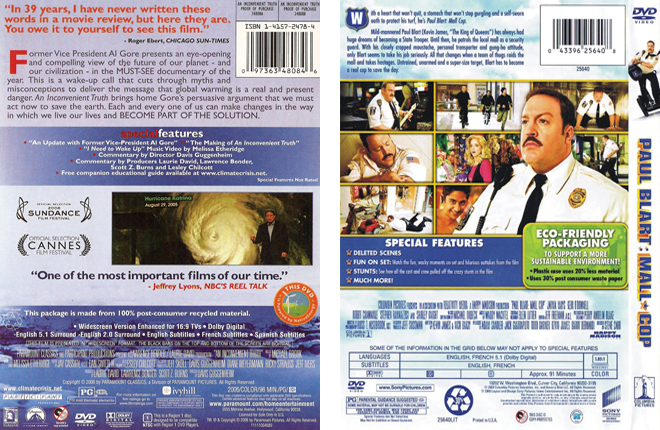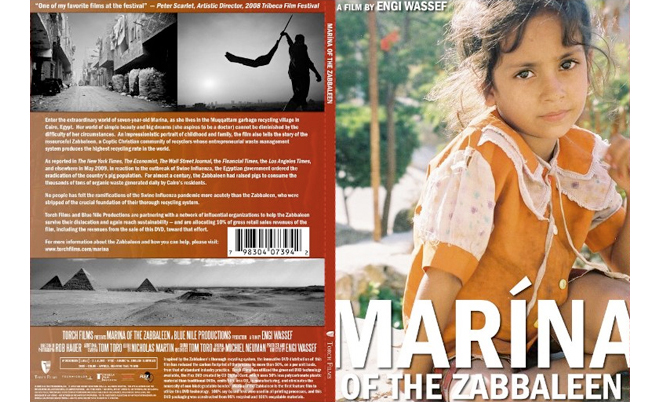Europe's online source of news, data & analysis for professionals involved in packaged media and new delivery technologies

FEATURE: Green packaging - what is the industry's commitment?
Al Gore’s award-winning documentary, An Inconvenient Truth, was released by Paramount in 2006 in a package that sets the sustainability bar by being made of 100% post-consumer waste recycled paper. LARRY JAFFEE, journalist and author, wonders if ‘going green’ is a serious commitment by the industry or merely paying lip service.
Sadly, few content providers, despite several seeming promising green pronouncements from Hollywood movie studios, have since then put as much attention into an environmentally conscious package. And that’s not because various “green options” don’t exist. Surely, there’s no shortage of vendors willing to sell DVD producers with the politically correct, recyclable flavour of the week. But one wonders whether the studios are merely paying lip service, or is it a marketing ploy at a time of flattening DVD sales?
Practicing what it preached
An Inconvenient Truth practiced what it preached in its packaging, whose manufacturer, Ivy Hill, owned by Cinram at the time, succeeded in making the smallest possible environmental footprint. A small circular logo the size of a pence coin depicted a graphic rendering of a windmill and text that states: “This DVD is powered by NativeEnergy,” which offers services that reduce carbon emissions to fight global warming (pictured below).
The DVD’s cardboard holder was shrink-wrapped in EarthFirst PLA film, compostable and entirely environmentally friendly – since it starts as a natural product and ends as a natural product with no impact on the environment. EarthFirst PLA film does not look any different than petrochemical based films. It functions in much the same way as other plastic films.
The film utilises Nature-Works PLA resin, made from 100% field corn. That’s not the only vegetable recently tapped for an optical disc. There’s also a disc tray from PaperFoam made out of potato starch and similar vegetable-based sources. When’s dinner? Back in 2003, Sanyo announced the world’s first optical disc comprised of polylactic acid derived from corn and completely biodegradable!
Dubbed the “MildDisk,” its commercial rollout unfortunately never came; one wonders why. But it’s interesting to know that roughly 85 corn kernels made up one disc. The press release noted, “The world corn population is about 600 million tons, less than 0.1% is needed to make 10 billion discs.”
Seven years later, Micah Solomon, founder & president of Oasis Disc Manufacturing in the US, was recently working in his garden and had Digipaks on his mind. Explains Solomon of his train of thought: “Instead of making these trays out of something that lasts forever in a landfill (plastic), why couldn’t they be made out of something more ephemeral-like plants?”
By fortuitous coincidence, a few days later Solomon received a call from a Dutch colleague from PaperFoam, who told him about potato-based trays they were manufacturing that used only about one-sixth of the usual energy and resulting emissions. The potato trays, a natural farm product, can either be recycled or put into your compost bin when no longer needed.
“We don’t charge extra for eco-trays,” Solomon says, noting that although the majority of his company’s business is music CD-oriented and that Oasis also offers an array of DVD packaging options. Less than half of the CD volume goes in 5-inch jewel cases. “Sixty percent are Digipaks,” he adds.
But Digipaks give off two-thirds less carbon than a fully plastic product, according to Julie’s Bicycle, a UK-based non-profit organisation whose mission is to help the creative industries lower their greenhouse emissions and create a low-carbon future.
While Julie’s Bicycle’s first two years has been focused on the UK music industry and CD packaging, Catherine Langabeer, director of its Industry Green assessment programme, expects a similar effort dedicated to the DVD industry that will soon start with a research project. For the CD study, Julie’s Bicycle signed all four major music label groups, accounting for 80% of all CD releases.

Wal-Mart leads the way
In the US usually what Wal-Mart wants Wal-Mart gets. This is particularly true in the home entertainment arena, where 20th Century Fox Home Entertainment (TCFHE) in 2006 followed the massive retailer’s lead in getting serious about sustainability. TCFHE’s parent company, News Corp, made carbon reduction a corporate priority, and DVD was one of the first units the media titan looked to demonstrate that it was serious about the environment.
As part of the Wal-Mart sustainability and packaging initiative, three major studios formed a Studio Working Group (SWG). These studios worked collaboratively to identify sustainability wins including decreasing the carbon footprint from DVDs and Blu-rays.
The first goal was to determine the emissions contributed from each step of the product supply chain for DVD production. The initial study revealed that packaging makes up about 30% of the footprint, a significant part of the product supply chain emissions, and therefore the SWG enlisted ClearCarbon, a private consulting firm, to further investigate the carbon contribution of nine different DVD packaging options. ClearCarbon declined to provide to DVD and Beyond data on how each package fared, claiming it was proprietary client information.
But ClearCarbon noted that TCFHE’s raw material emissions in 2008 dropped by 13% almost exclusively to the less heavy case weight from its levels in 2006 when it did the studio’s first DVD carbon study. Fox, which did not respond to requests for more recent figures, has begun to use lighter plastic cases with die-cuts, which explains the studio’s carbon reduction.
Transportation emissions decreased by almost 20% attributable to an increasing preference for ground transport in place of more carbon-intensive air transport. TCFHE’s DVD replication facility achieved a 10% absolute reduction in emissions due to several energy efficiency initiatives. And perhaps, most importantly, the TCHFE DVD footprint decreased by over 5% on a per unit basis from 2006 to 2008 translating into savings of tens of millions of US dollars based on total DVD discs sold.
ClearCarbon concluded that the total carbon emission per DVD was 0.75 pounds of carbon dioxide. What was particularly notable about the Fox DVD study was the studio’s willingness to share it with rivals.
Year One under Sony rollout
While current Fox numbers weren’t available, Sony Pictures Home Entertainment (SPHE) provided us with an update since it put out in May 2009 its first DVD, Paul Blart: Mall Cop, in a package that used less polypropylene plastic and more recycled paper (pictured above).
At the time, Sony said all its single-disc standard definition DVDs would use paper made from 30% post-consumer waste. Previously, the studio used 100% virgin paper. Under the plan, Sony’s discs were to contain 20% less plastic and covered with plastic shrink-wrap that is 20% lighter.
Robert Ziegler, SPHE senior vice president of operations, reports that since May 2010, all of Sony’s 240 new release DVDs and thousands of back catalogue titles have been cased in the Eco-case which it gets from Viva and AGI, representing 125 million to 150 million units distributed in the US.
For Blu-ray, SPHE started using the lighter case for new (40 titles to date) and back catalogue in April 2010, amounting together to less than 10 million units in the US. SPHE has reduced its carbon footprint by 20% since implementing the new packaging, which weighs 47 grams for DVD as opposed to the previous standard case’s 57 grams; and 47.5 grams for the new Blu-ray cases, compared with 59 grams for the old version.
“The Eco-case is also being used in Europe, but not all territories yet,” Ziegler tells DVD and Beyond. But the plan is to roll it out globally. Sony enlisted Asheville, NC-based environmental non-profit Dogwood Alliance to review its packaging and implement changes that will “ultimately lead to healthier forests, cleaner drinking water and air, sustainable communities, and strengthen the fight against global climate change.”
Sony also worked with the Natural Resources Defense Council and the US Environmental Protection Agency to examine its supply chain’s carbon footprint. Sony actually beat by 1 million pounds its pledge several years ago to reduce carbon emissions associated with its DVD manufacturing by 2 million pounds in North America by 2010.
Indie goes green, too
Going green needn’t be the domain of just the majors. Marina of the Zabbaleen, an independent feature film from Torch Films and Blue Nile Productions, tells the story of a Cairo, Egypt, community of recyclers whose entrepreneurial waste management system produces the highest recycling rate in the world. The film serves as a benchmark for green film distribution and marketing; its marketing campaign has been completely paperless.
Theatrical distribution utilises digital cinema technology, and a DVD that reduces the carbon footprint by 56% on a per-unit basis during manufacturing from that of standard industry practice. Torch Films is utilising what it claims to be “the greenest DVD technology available.” Marina is the first feature film stamped onto the Flex DVD, created by CD Digital Card. 100% recyclable, the disc uses 50% less polycarbonate, eliminates the necessity of non-biodegradable bonder, and use 100% soy-based inks.

CD Digital Card achieved a milestone for its Flex disc technology when it recently received approval by the US Postal Office for bulk distribution of the discs at $0.19 per mailer when sorted, the same rate as a standard envelope, reducing the cost of mailing a standard DVD-5 format disc by 50%.
Flex DVD is not the first disc to employ a ‘less is more’ philosophy. The EcoDisc, from Swiss-based Ecodisc Technology, comes to mind. (An interview of the company director will be published here shortly). EcoDisc recently received a comprehensive clean bill of compatibility health from Testronics’ testing.
Other green media
There are many ways that physical media can play a role in improving the environment. For example, a few years ago I wrote about Acutrack, a media manufacturer in California that urged an American B2B client to replace a 1,000-page catalogue it had shipped to 780 dealers with a single, searchable DVD-ROM. The company’s cost per catalogue went from $136 to $3. Shipping went from $11 per catalogue via private courier United Parcel Service to ¢0.58 via the US Postal Service.
In the video game world, Ubisoft announced on 19 April an environmental initiative to eliminate paper game manuals, replacing them with an in-game digital manual for all titles on Sony’s PlayStation3 system and Xbox 360 video game and entertainment system from Microsoft. According to Ubisoft, it’s the video game industry’s first such initiative, and launches worldwide with Shaun White Skateboarding this autumn 2010.
Putting a PR spin to the news, Ubisoft says its digital game manuals will provide multiple benefits for the player and the environment. Including the game manual directly in the game will offer the player easier and more intuitive access to game information, as well as allow Ubisoft to provide gamers with a more robust manual. Ubisoft began featuring digital game manuals in its PC titles distributed in North America since March.
According to Ubisoft, one ton of paper used in the company’s game manuals consumes an average of two tons of wood from 13 trees, with a net energy of 28 million BTU’s (equivalent to average heating and energy for one home/year), greenhouse gases equivalent of over 6,000 lbs of CO2, and wastewater of almost 15,000 gallons.
In addition to Ubisoft’s efforts to decrease paper usage in its game packaging, Ubisoft has partnered with Technimark, Inc. to release what it claims to be the entertainment industry’s most environmentally-responsible DVD case for all of its future PC titles in North America. The 100%-recycled polypropylene ‘ecoTech’ DVD case debuted on 30 April with Ubisoft’s Tom Clancy’s Splinter Cell Conviction PC video game. The ecoTech is a product of Technimark’s Sustainable Products Group.
Julie’s Bicycle’s Catherine Langabeer agrees that the seemingly daily news about various natural disasters around the globe helps organisations like hers raise green consciousness. “If that helps shift people’s mindset to the dangers of altering the atmosphere to levels it’s never reached before, then it’s all for the good. We have to operate from a point of humility.
“Recent events probably help people experience and anticipate the impact that future disasters can have on daily life. There is a potential positive benefit how people are thinking about how contemporary civilisation is heavily dependent upon ecosystems beyond our control.”
WAL-MART’S 7 ‘R’ OF SUSTAINABLE PACKAGING
Remove Eliminate unnecessary packaging, boxes or layers, and harmful materials.
Reduce “Right-size” packages, optimize material strength, and design packages appropriately for contents and merchandising requirements.
Reuse Wal-Mart has a goal that all transport packaging will be reused or recycled by 2011 through improved pallets and reusable plastic containers (RPCs).
Renew(able) Use materials made of renewable resources as measured using ASTM D6866, or select biodegradable materials that meet ASTM D6400 or ASTM D6868.
Recycle(able) Use materials made of the highest recycled content without compromising quality, including post-consumer recycled material (PCR) where appropriate. Components should be chosen based on recycle-ability post-use, with a goal of increasing the municipal recycling rate to 35 percent by 2011.
Revenue Achieve all principles at cost parity or cost savings, which requires a supply chain approach.
Read Get educated on sustainability and how suppliers play a part.
Based in New York, LARRY JAFFEE edited Medialine from 1998 to 2005, and oversaw its annual DVD conference. He’s been a regular contributor to One to One and edited two issues of MediaPack. Jaffee was also a columnist for Mediaware and a consultant to the Content Delivery & Storage Association (formerly IRMA). He is the author of Albert Square & Me: The Actors of EastEnders. Contact: lsjaffee@gmail.com
This is one of many high-caliber features included in the annual DVD and Beyond 2010 magazine. Ask for your free copy.
Story filed 05.10.10




















